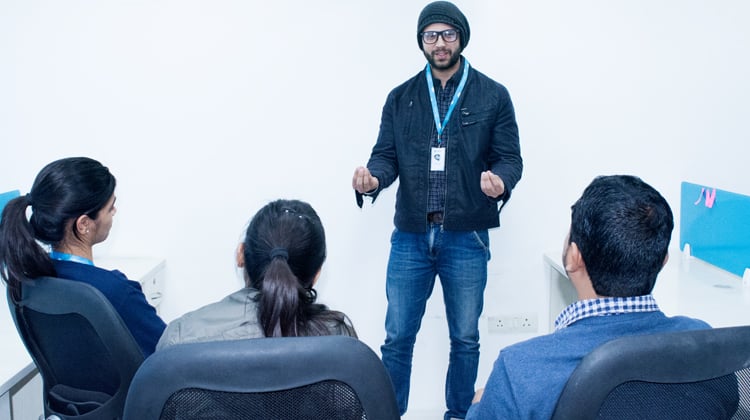Motion Graphics is all about you and your creativity. How you craft your thoughts into a picture? How you color your perceptions while expressing your opinion or how you build up the blocks of graphics of your imaginary world to demonstrate the problem or a specific use case.
When anxiety, pressure, and the intensity of blood spike the nerves, all together generally block your thoughts to express yourself to the employer. As a result, the job seeker often chokes while representing himself.
Every young brain prepares itself to go through the phase of the interview. Newbies are often curious to know the answers to Motion Graphics interview questions for freshers. The queries not only help them to answer in the session but also somehow build their morale to the next upcoming.
Here is a list of some questions that can aid the freshers in boosting their confidence while preparing for their motion graphics interview.
Q1. Introduce yourself?
Answer:- This is the first question that the employer asks. Answer it in a precise way giving them the gist of your doing.
Here one is usually asked for his personality, including who and what you are, some qualifications, experience if the person has, and perhaps some clips from his career so far. This section is where you don’t want to get in much detailing; think of this phase as a debut to tell the person before you about who you are.
If the job is your first one, then tell them what fascinated you about this domain. What dragged you to make this line your profession!
Here you want to be as civil as possible, with a prime concentration on what you have achieved so far down the road of life.
Q2. What type of design initiatives intrigue you?
Answer:- The next query that comes from the other side of the table is what designs fascinate you or lure you. To tackle this sort of question, answer in this manner.
To like the job you are going to hire for a will might not be an ultimate choice for employment, but a wise employer is familiar with the fact that happy workers deliver better work and especially then when they enjoy the work they are doing.
Every motion graphic artist has his or her one specialty, something they keep in the priority section.
Raise the Topography of your designs.
If the fortunes are on your side and you get the job you desire, you will always be in the best shape. On the downside, if the situation is totally different from the choice, formulate your answer, manipulate yourself in the best honest way to convince the person on the opposite side with some firm and careful choice of words and logic.
At the end of this section, they must believe that they might get a better one, but they will surely miss the enthusiasm, dedication, and passion you have.
You can also win his or her heart by saying that you wish to work in teams rather than a lonely man. You can give the example of “united we stand and scattered we fall.” This will genuinely leave a remarkable impact on their mindsets.
Q3. What about the graphic design process?
Answer:- This answer belongs to your expertise so, prepare this in the best and most presentable form that nobody else can explain it better than you. After all, this is what you chose in the first place, so who else will express your desires, work, and zeal better than you. This is where you can flaunt your motion graphics skills.
Tell them how time passes while you are onto your machine crafting the graphics, putting your thoughts into geometrical figures, how you fill colors to your intellectuals, how you bring out stories from your piece of art.
Shock them by telling how the art can never die, and it just reshapes from time to time in new forms.
Q4. Which design software or tool you prefer the utmost?
Answer:- I’ve used software like Adobe AfterEffects for layer-based tasks, and eventually, it’s a hybrid of two, i.e., editing and photoshop software. The software has seamless use of AE within the range of the Creative Cloud ecosystem.
Some other honorable mentions are Nuke Studio for high-end Com[positing and 3D Compositing, Fusion 8 for particle generation and 3D compositing too, Apple Motion for quick motion projects along with the creation of FCPX Template, even the graphics for videos, Cinema 4D for better 3D Animation, 3D Modeling, finally, Maya for a cut to edge 3D Modeling, 3D Animation and texturing.
If you are already familiar with tools of motion graphics, then you’ll have no hesitation to answer this question.
Worst case scenario -- you don't know their tool. In that case, tell them that nobody in this entire world knows everything. So, there’s always time to learn something new and let this be the moment for your fresh start to a new tool. With the right motivation and zeal, one can learn anything in no time.
You can also tell them that you have hands-on some other tools too.
Q5. What can you do in After Effects?
Answer:- First of all, I can manage the workspaces, panels, and viewers of the software, where one gets deeper into the application window, stacked panels, and the individual ones. On top of this, I can craft and save the altered workspaces or get them to their original state or delete them as per requirement.
I can work with layers and the properties associated with it. Finally, I can make the compositions out of the layers.
Q6. Do you know anything about character masking?
Answer:- I'm pretty well aware of the masking feature of the tool. I even know how to masking features onto the various elements. While doing the Animation, I can mask the characters' general practice while animating with the text and crafting graphics.
On top of that, I can mask the images. Along with this knowledge of rendering, the masked objects also come in the package.
Q7. What about the ‘camera view and animate’?
Yes! I’m completely aware of the notion behind the camera view and camera animation properties. I’m quite familiar with the camera settings and the assets to alter the viewpoints timely.
I know how to take in and around the environment, rotate and animate it. Here I can live the camera hand-operated and can alter the through settings. The other thing that I can do is to tail the camera footprints with the auxiliary camera on the process of composting. I use Depth of the Field and make use of the variables to alter the depth parameter to accomplish the real and precise look.
Q8. Tell us something about Lighting, Texturing, and Masking?
Answer:- Lighting - This may be defined as the process of providing artificial light effects for the podium or a film. The Lightning Designer (LD) also indulges in the stage manager's work to present the control programming.
Texturing - The process of delivering the utmost detailing in the objects is called Texturing. It can be related to anything like characters, landscapes, objects, terrain, reflections, name it.
Over to You
Every brain has its power to work accordingly. The web developer is intrigued by the web applications; writers feel at ease in writing and spreading the information via the contents. Similarly, Graphic artists have their own methods to reveal their thoughts into the story to make the audience believe what they believe.
The initial trauma of the interview can be veiled off from this quick delivery of a few fundamental questions.
Good-luck for your motion graphics career path. Hope you crack your motion graphics interview!





